Effect of Lignin Modification of Recycled and Fresh Wood Fibers on Physical, Mechanical, and Thermal Properties of Fiberboard
Abstract
:1. Introduction
2. Materials and Methods
2.1. Preparation of Raw Materials
2.2. Production of MDF Panels
2.3. Determination of Physical and Mechanical Properties
2.4. Thermogravimetric (TGA) Analysis
2.5. Differential Scanning Calorimetry (DSC) Analysis
3. Results and Discussion
3.1. Physical and Mechanical Properties
3.2. Thermal Analysis
3.2.1. DSC Analysis
3.2.2. TGA Analysis
4. Conclusions
Author Contributions
Funding
Data Availability Statement
Conflicts of Interest
References
- Zimmer, A.; Bachmann, S.A.L. Challenges for recycled medium-density fiberboard (MDF). Results Eng. 2023, 19, 101277. [Google Scholar] [CrossRef]
- US EPA. Municipal Solid Waste in the United States: 2003 Facts and Figures; U.S. Environmental Protection Agency: Washington, DC, USA, 2005.
- Antov, P.; Mantanis, G.I.; Savov, V. Development of wood composites from recycled fibres bonded with magnesium lignosulfonate. Forests 2020, 11, 613. [Google Scholar] [CrossRef]
- Thirugnanam, S.; Srinivasan, R.; Anand, K.; Bhardwaj, A.; Puthilibai, G.; Madhu, P.; Karthick, A. Utilisation possibilities of waste medium-density fiberboard: A material recycled process. Mater. Today Proc. 2022, 59, 1362–1366. [Google Scholar] [CrossRef]
- Lubis, M.A.R.; Hong, M.K.; Park, B.D.; Lee, S.M. Effects of recycled fiber content on the properties of medium density fiberboard. Eur. J. Wood Prod. 2018, 76, 1515–1526. [Google Scholar] [CrossRef]
- Hagel, S.; Joy, J.; Cicala, G.; Saake, B. Recycled of waste mdf by steam refining: Evaluation of fiber and paper strength properties. Waste Biomass Valor 2021, 12, 5701–5713. [Google Scholar] [CrossRef]
- Moezzipour, M.; Abdolkhani, A.A.; Doosthoseini, K. Chemical changes of wood fibers after hydrothermal recycled of MDF wastes. J. Indian Acad. Wood Sci. 2017, 14, 133–138. [Google Scholar] [CrossRef]
- He, Y.; Chen, Q.; Wu, D.; Zhou, M.; Wang, T.; Lu, C.; Zhang, L.; Liu, H.; Liu, C. Effect of multiscale reinforcement by fiber surface treatment with polyvinyl alcohol/graphene oxide/oxidized carbon nanotubes on the mechanical properties of reinforced hybrid fiber composites. Compos Sci. Technol. 2021, 204, 108634. [Google Scholar] [CrossRef]
- He, Y.; Yang, S.; Liu, H.; Shao, Q.; Chen, Q.; Lu, C.; Jiang, Y.; Liu, C.; Guo, Z. Reinforced carbon fiber laminates with oriented carbon nanotube epoxy nanocomposites: Magnetic field assisted alignment and cryogenic temperature mechanical properties. J. Colloid Interface Sci. 2018, 517, 40–51. [Google Scholar] [CrossRef]
- Gumowska, A.; Kowaluk, G. Physical and Mechanical Properties of High-Density Fiberboard Bonded with Bio-Based Adhesives. Forests 2023, 14, 84. [Google Scholar] [CrossRef]
- Mulenga, T.K.; Ude, A.U.; Vivekanandhan, C. Techniques for Modelling and Optimizing the Mechanical Properties of Natural Fiber Composites: A Review. Fibers 2021, 9, 6. [Google Scholar] [CrossRef]
- Roffael, E.; Behn, C.; Schneider, T.; Krug, D. Bonding of recycled fibres with urea-formaldehyde resins. Int. Wood Prod. J. 2016, 7, 36–45. [Google Scholar] [CrossRef]
- Hwang, C.; Hse, C.; Shupe, T.F. Effects of recycled fiber on the properties of fiberboard panels. Forest Prod. J. 2005, 55, 60–64. [Google Scholar]
- Olgun, Ç.; Ateş, S. Characterization and comparison of some kraft lignins ısolated from different sources. Forests 2023, 14, 882. [Google Scholar] [CrossRef]
- Pizzi, A. Wood products and green chemistry. Ann. For. Sci. 2016, 73, 185–203. [Google Scholar] [CrossRef]
- Karthäuser, J.; Biziks, V.; Mai, C.; Militz, H. Lignin and lignin-derived compounds for wood applications—A review. Molecules 2021, 26, 2533. [Google Scholar] [CrossRef] [PubMed]
- Rinaldi, R.; Jastrzebski, R.; Clough, M.T.; Ralph, J.; Kennema, M.; Bruijnincx, P.C.A.; Weckhuysen, B.M. paving the way for lignin valorisation: Recent advances in bioengineering, biorefining and catalysis. Angew. Chem. Int. Ed. 2016, 55, 8164–8215. [Google Scholar] [CrossRef]
- Younesi-Kordkheili, H.; Pizzi, A.; Niyatzade, G. reduction of formaldehyde emission from particleboard by phenolated kraft lignin. J. Adhes. 2016, 92, 485–497. [Google Scholar] [CrossRef]
- Gao, S.; Liu, Y.; Wang, C.; Chu, F.; Xu, F.; Zhang, D. Synthesis of lignin-based polyacid catalyst and its utilization to ımprove water resistance of urea–formaldehyde resins. Polymers 2020, 12, 175. [Google Scholar] [CrossRef]
- Michanicki, A. Recovery of fibers and particles from wood-based products. In Proceedings of the Forest Products Society Conference on Use of Recycled Wood and Paper in Building Applications, Madison, WI, USA, 9–11 September 1996; pp. 115–119. [Google Scholar]
- Anonymous. LineoTM Prime W by Stora Enso; Product brochure; Stora Enso Company: Helsinki, Finland, 2020; 4p. [Google Scholar]
- Anonymous. Technical Properties of Urea-Formaldehyde Resin; Product brochure; Kastamonu Integrated Wood Company, Sanayi district, Technopark Boulevard: Istanbul, Turkey, 2023; 2p. [Google Scholar]
- EN 310; Wood Based Panels, Determination of Modulus of Elasticity in Bending and Bending Strength. European Committee for Standardization: Brussels, Belgium, 1993.
- EN 319; Particleboards and Fiberboards, Determination of Tensile Strength Perpendicular to Plane of the Board. European Committee for Standardization: Brussels, Belgium, 1993.
- EN 311; Wood-Based Panels-Surface Soundness. European Committee for Standardization: Brussels, Belgium, 2002.
- EN 317; Particleboards and Fiberboards, Determination of Swelling in Thickness after Immersion. European Committee for Standardization: Brussels, Belgium, 1993.
- EN 120-1; Determination of Formaldehyde Content in Fiberboard by Using Perforator Method. European Committee for Standardization: Brussels, Belgium, 1994.
- Zeng, Q.; Lu, Q.; Zhou, Y.; Chen, N.; Rao, J.; Fan, M. Circular development of recycled natural fibers from medium density fiberboard wastes. J. Clean. Prod. 2018, 202, 456–464. [Google Scholar] [CrossRef]
- Lisý, A.; Ház, A.; Nadányi, R.; Jablonský, M.; Šurina, I. About Hydrophobicity of Lignin: A Review of Selected Chemical Methods for Lignin Valorisation in Biopolymer Production. Energies 2022, 15, 6213. [Google Scholar] [CrossRef]
- Bütün-Buschalsky, F.Y.; Mai, C. Repeated thermo-hydrolytic disintegration of medium density fibreboards (MDF) for the production of new MDF. Eur. J. Wood Prod. 2021, 79, 1451–1459. [Google Scholar] [CrossRef]
- Roffael, E.; Dix, B.; Behn, C.; Bär, G. Use of UF-bonded recycled particle- and fibreboards in MDF-production. Eur. J. Wood Prod. 2010, 68, 121–128. [Google Scholar] [CrossRef]
- Wang, Y.-Y.; Meng, X.; Pu, Y.J.; Ragauskas, A. Recent advances in the application of functionalized lignin in value-added polymeric materials. Polymers 2020, 12, 2277. [Google Scholar] [CrossRef]
- Mohammed, F.A. Increasing the Reactivity of Kraft Lignin by İmplementing Biobased Processes. Master’s Thesis, Universität für Bodenkultur Wien University of Natural Resources and Life Sciences, Vienna, Austria, 2020. [Google Scholar]
- Yang, G.; Gong, Z.; Luo, X.; Chen, L.; Shuai, L. Bonding wood with uncondensed lignins as adhesives. Nature 2023, 621, 511–515. [Google Scholar] [CrossRef]
- Pizzi, A. Advanced Wood Adhesives Technology; Marcel Dekker Inc.: New York, NY, USA, 1994. [Google Scholar]
- Rowell, R.M.; LeVan-Green, S.L. Chapter 6: Thermal properties. In Handbook of Wood Chemistry and Wood Composites; Rowell, R.M., Ed.; CRC Press: Boca Raton, FL, USA, 2005; pp. 121–138. [Google Scholar]

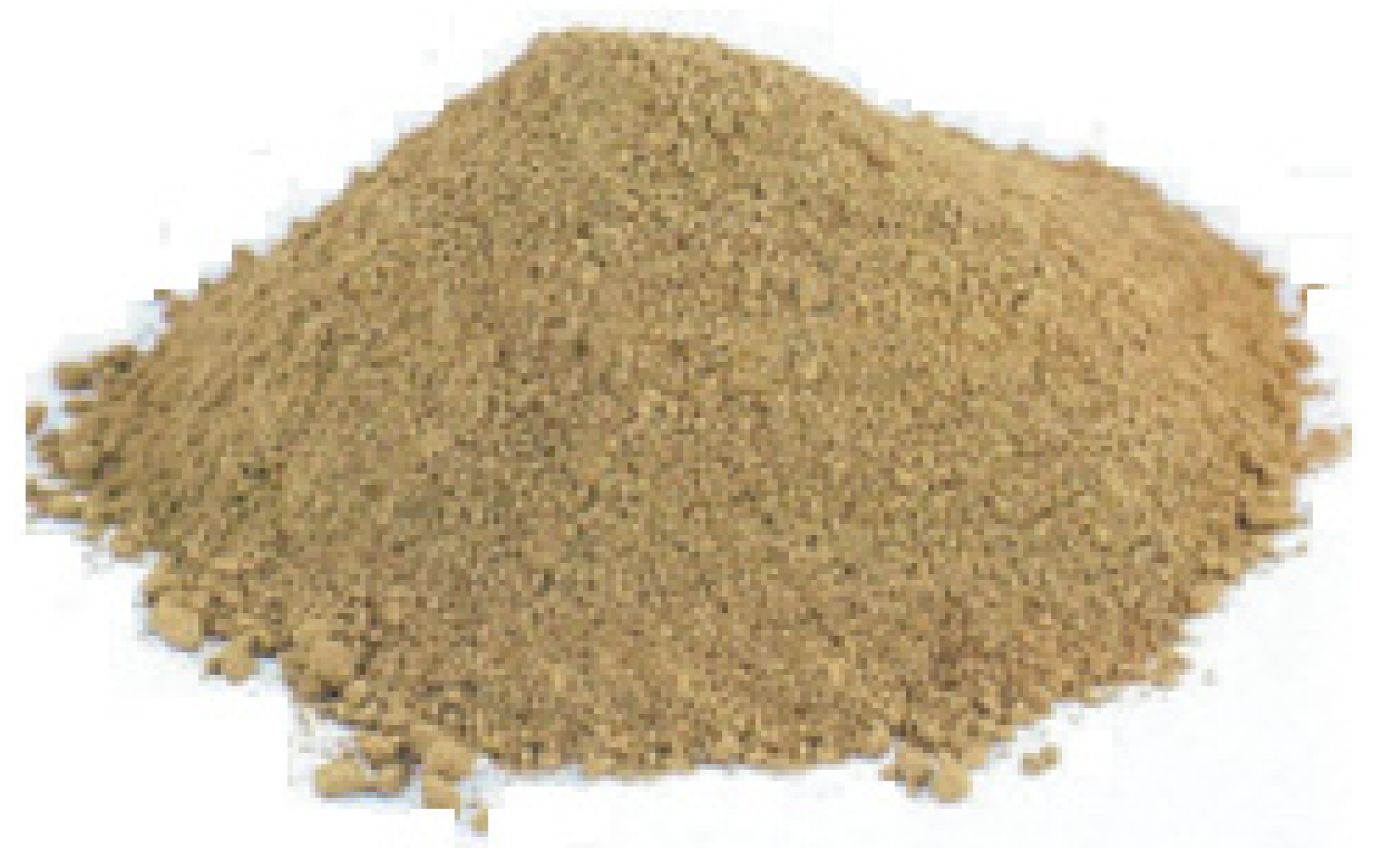
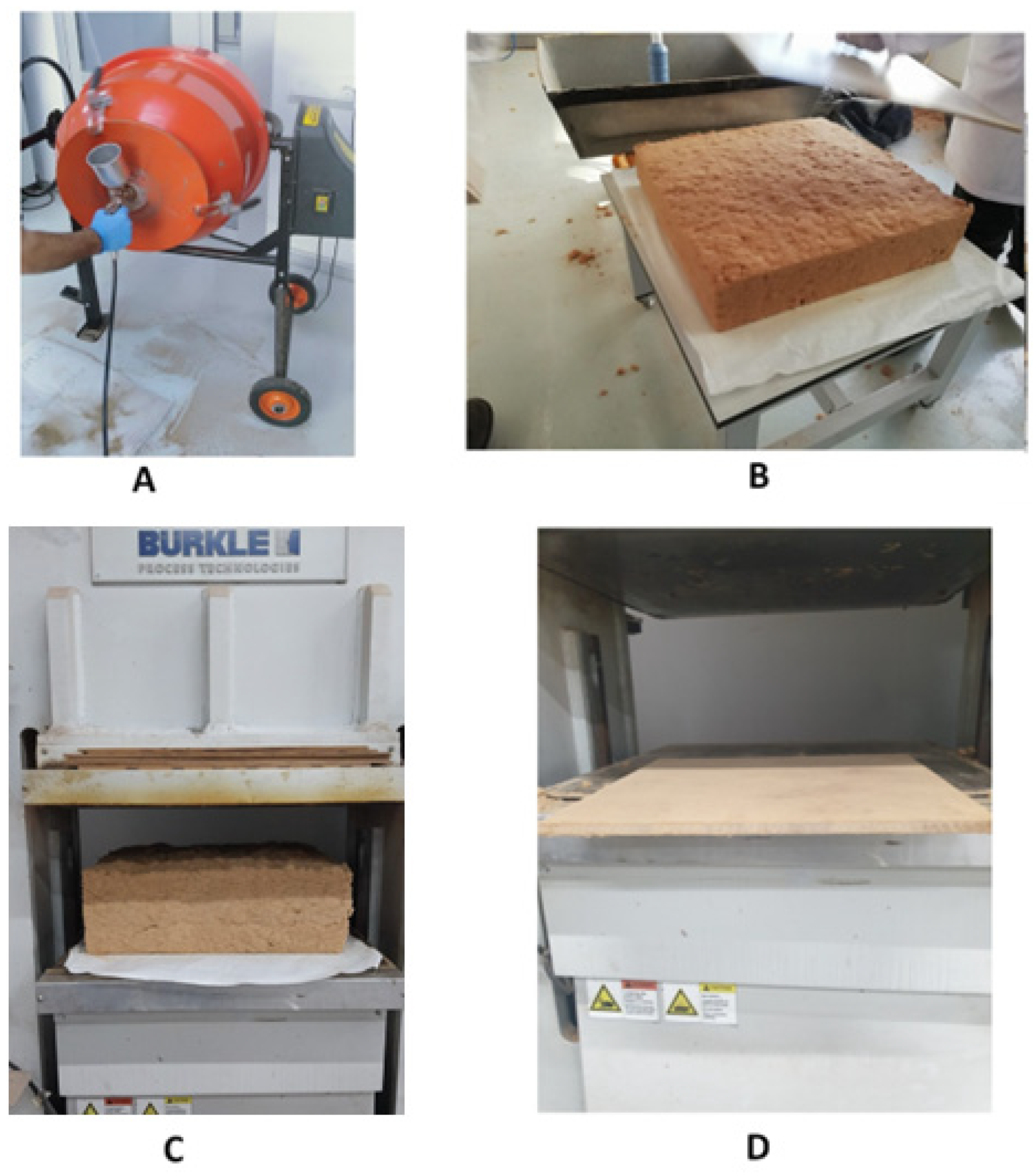
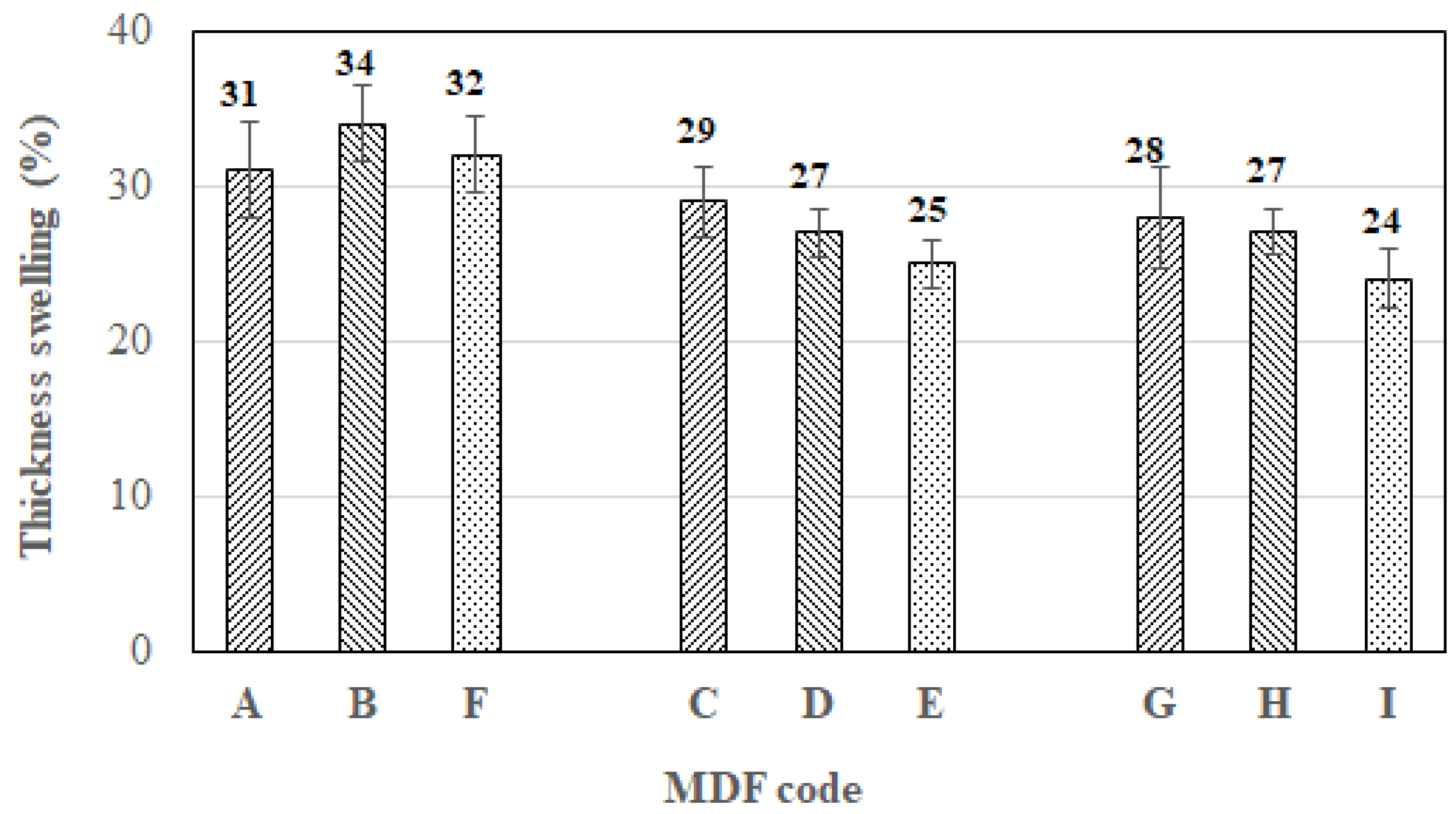
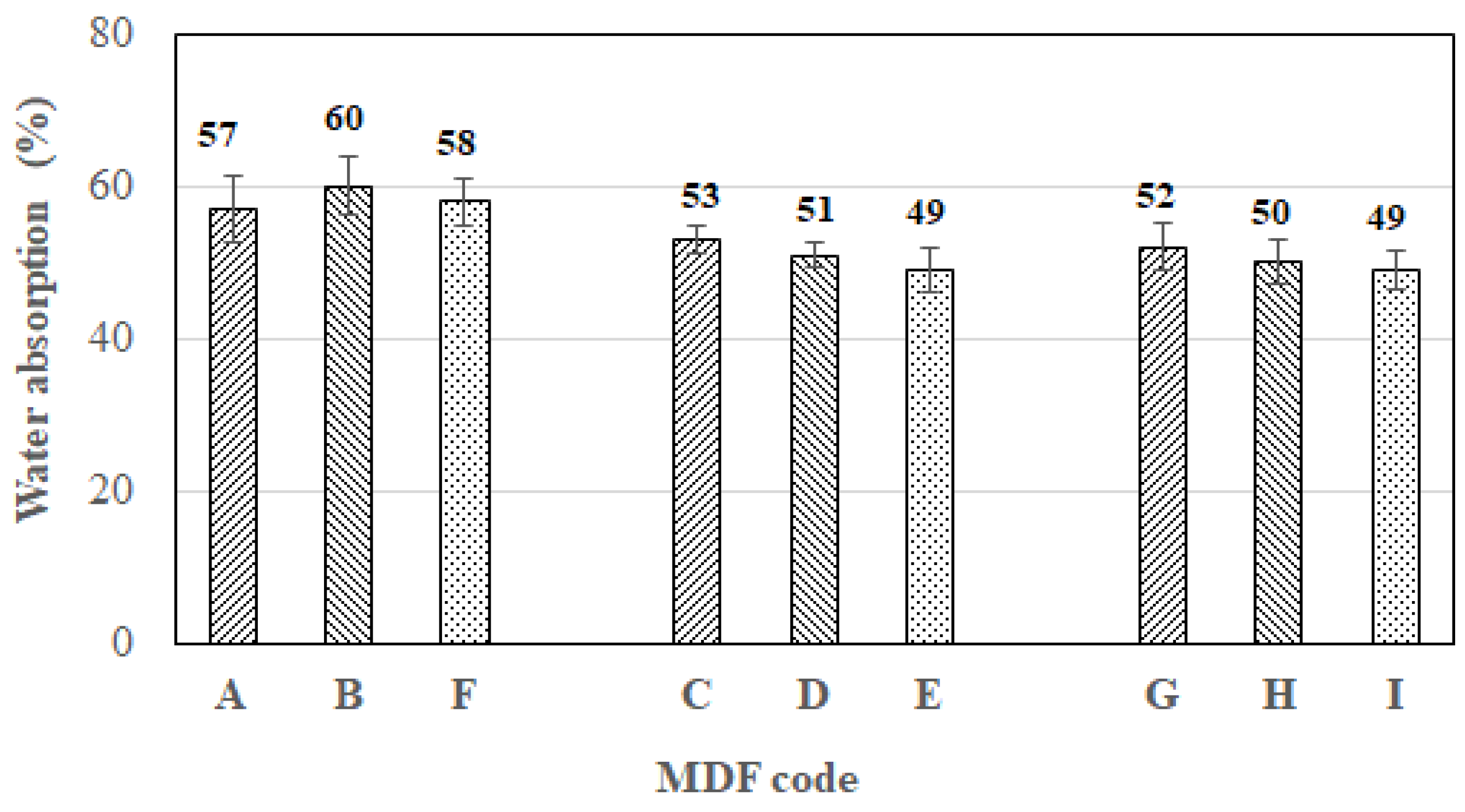
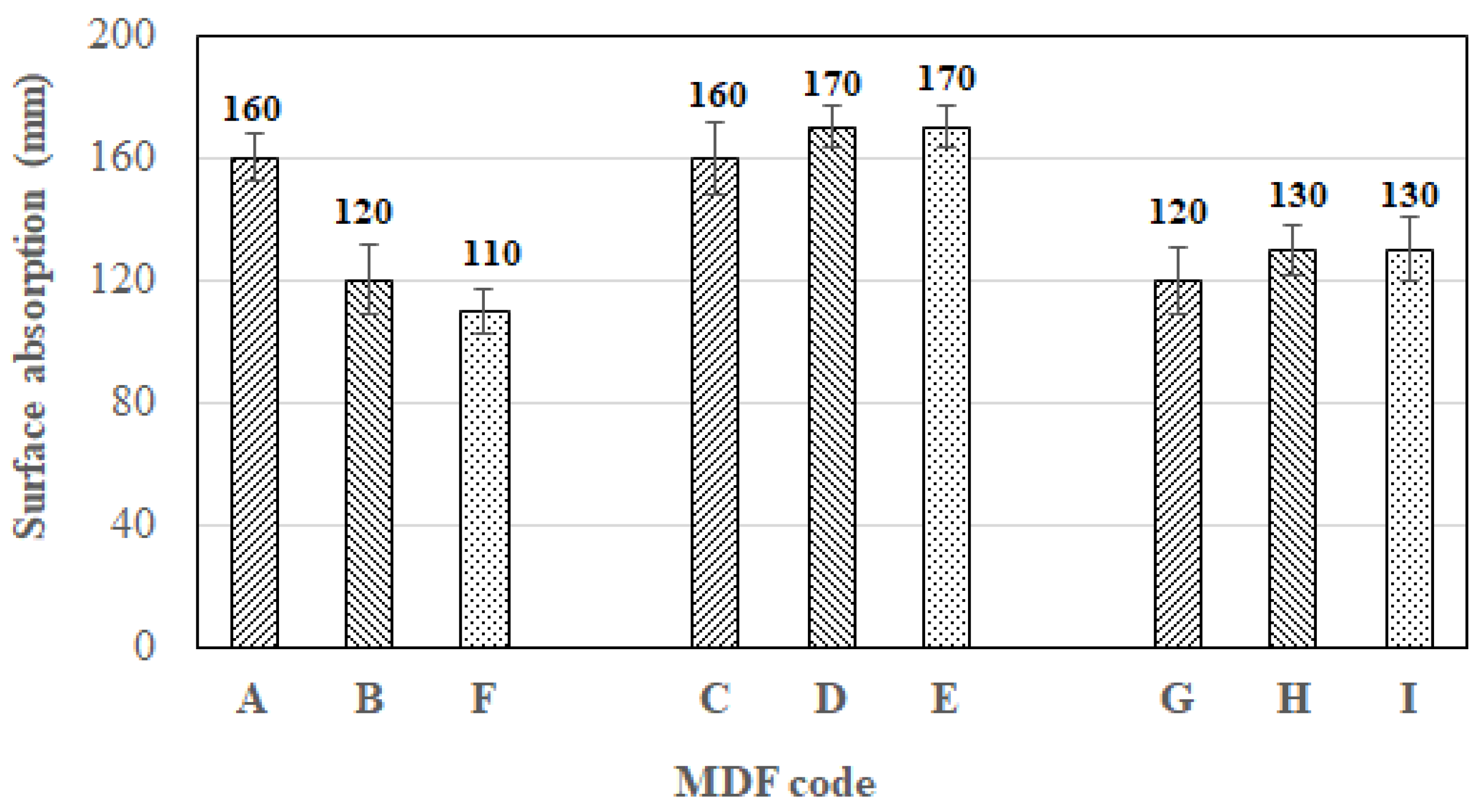
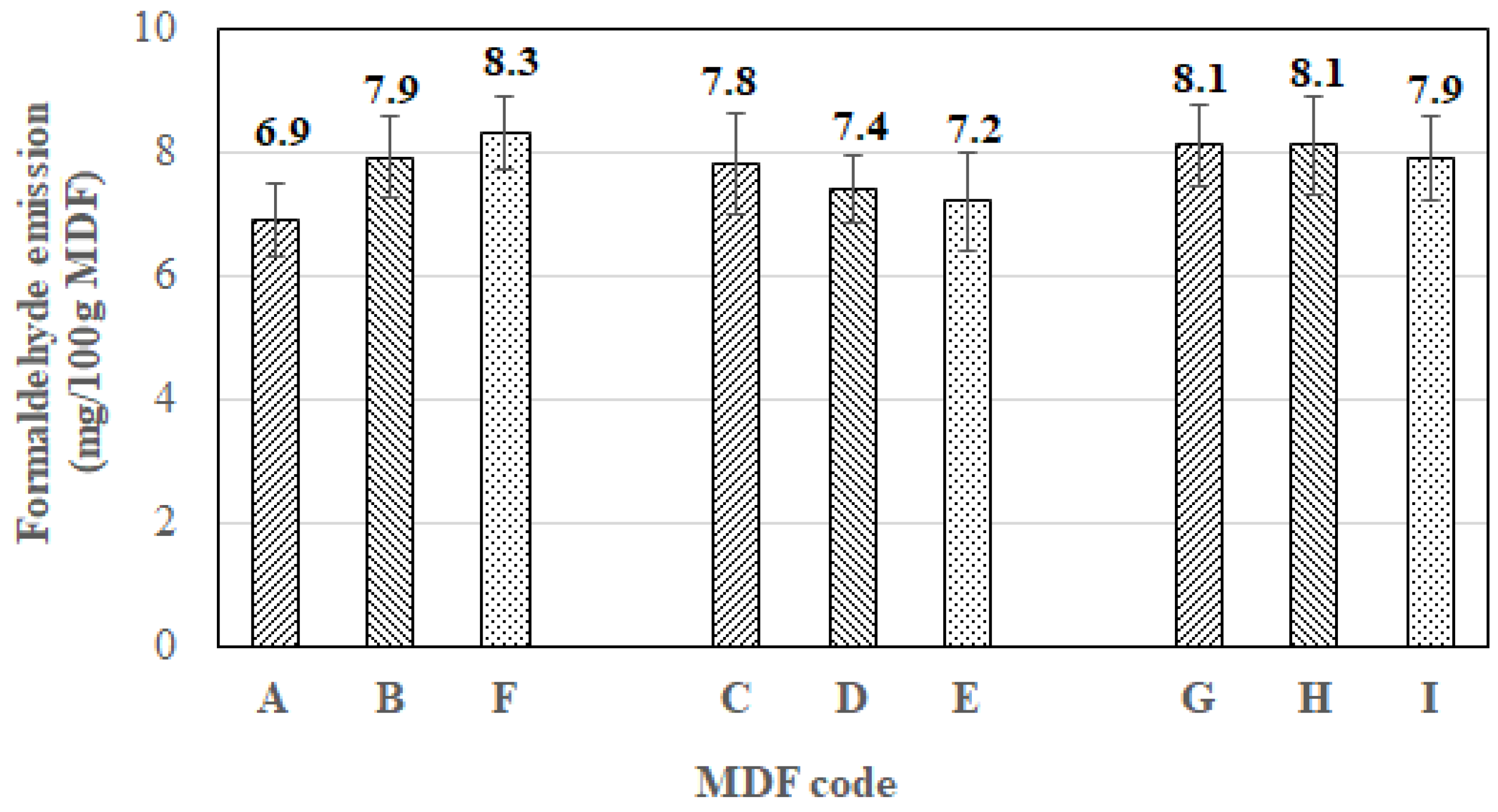
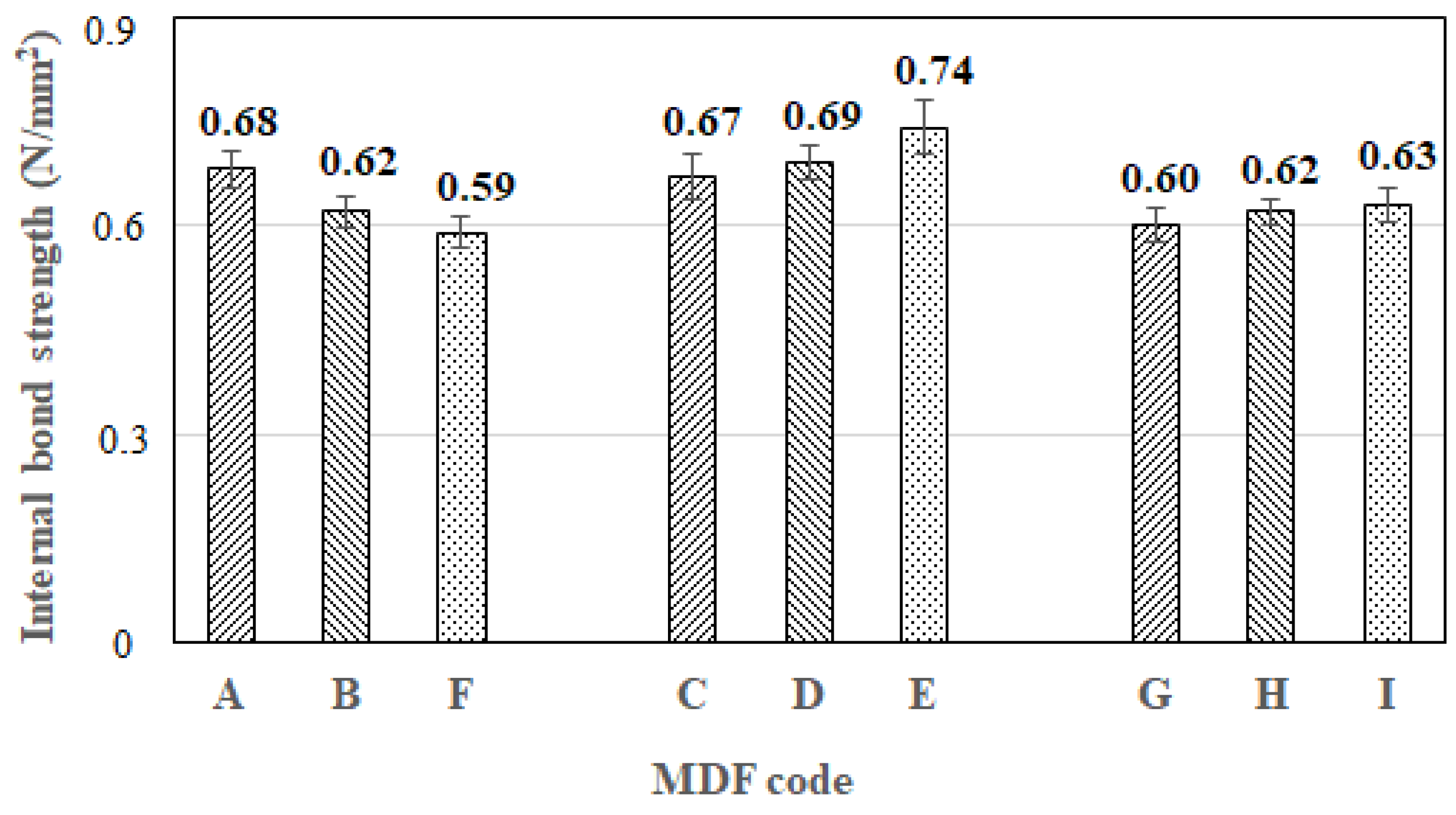
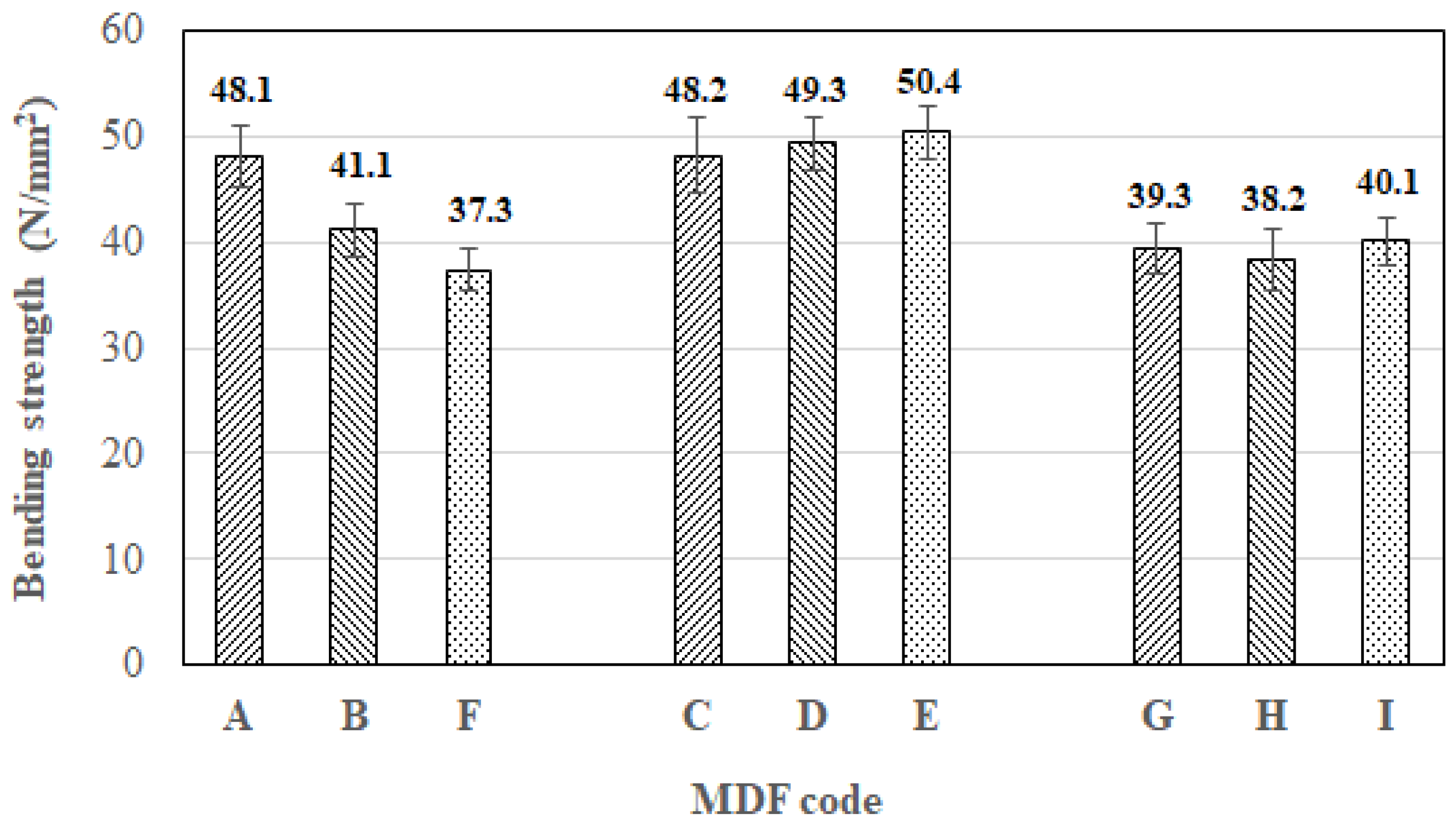
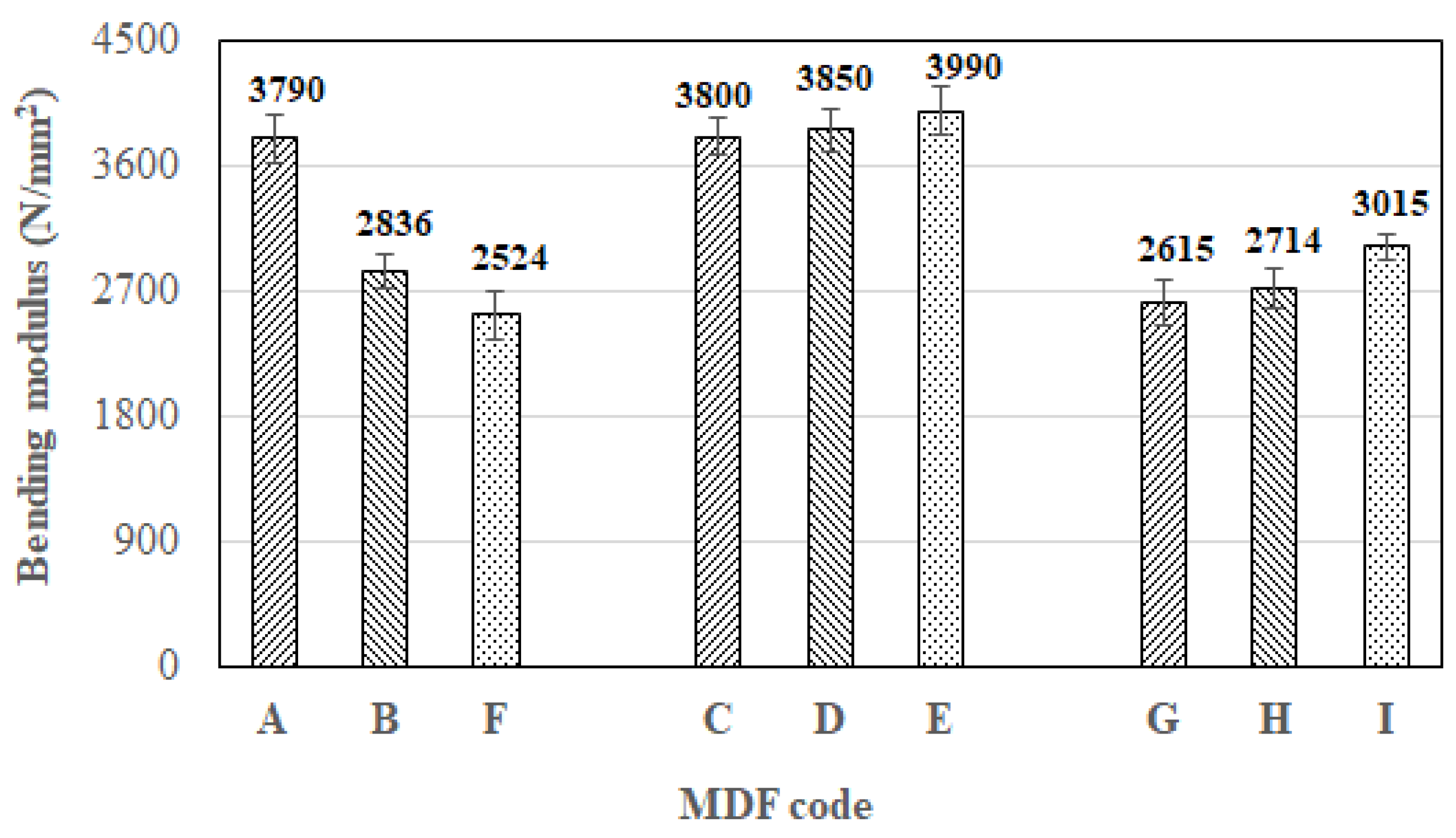
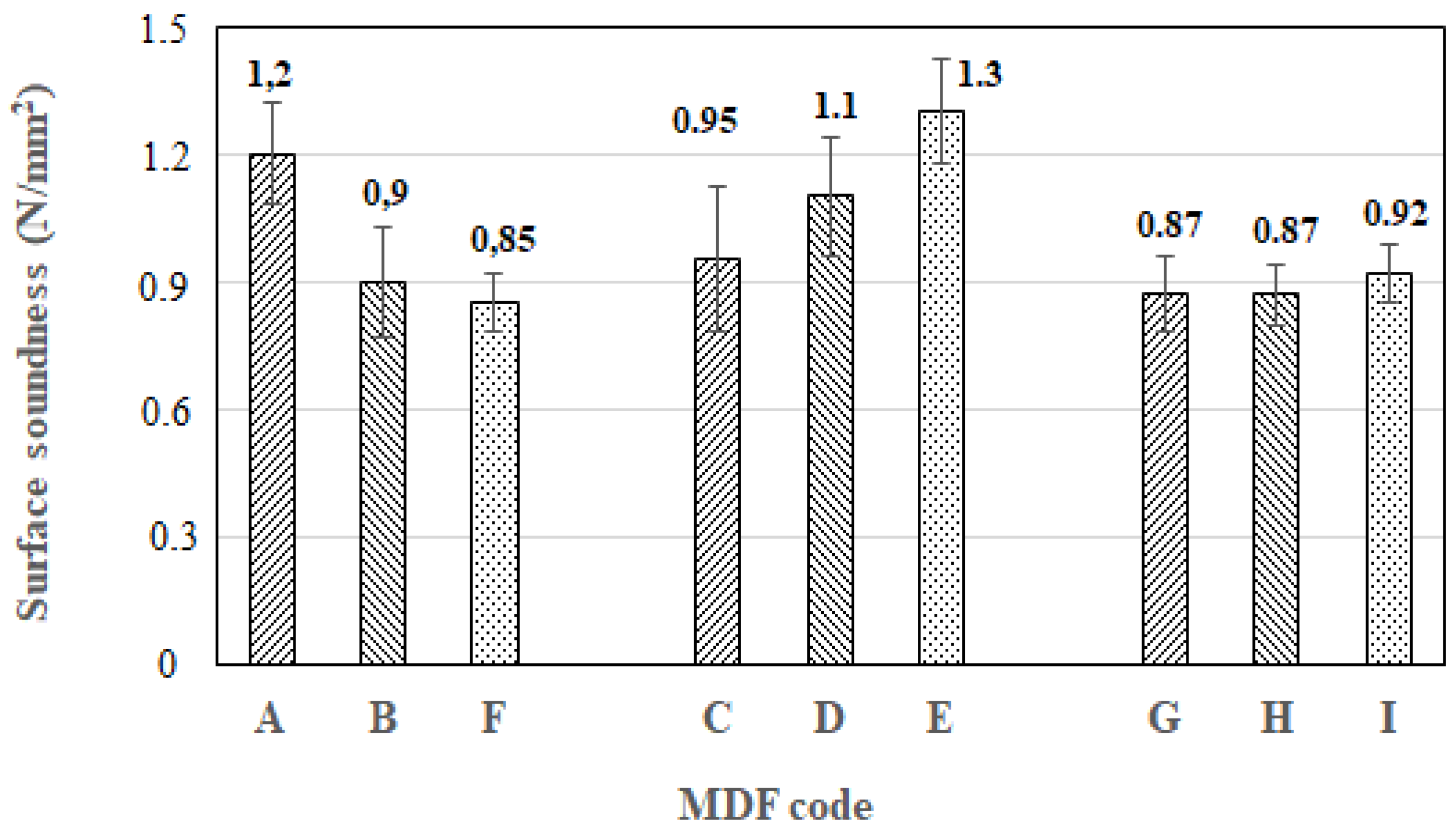
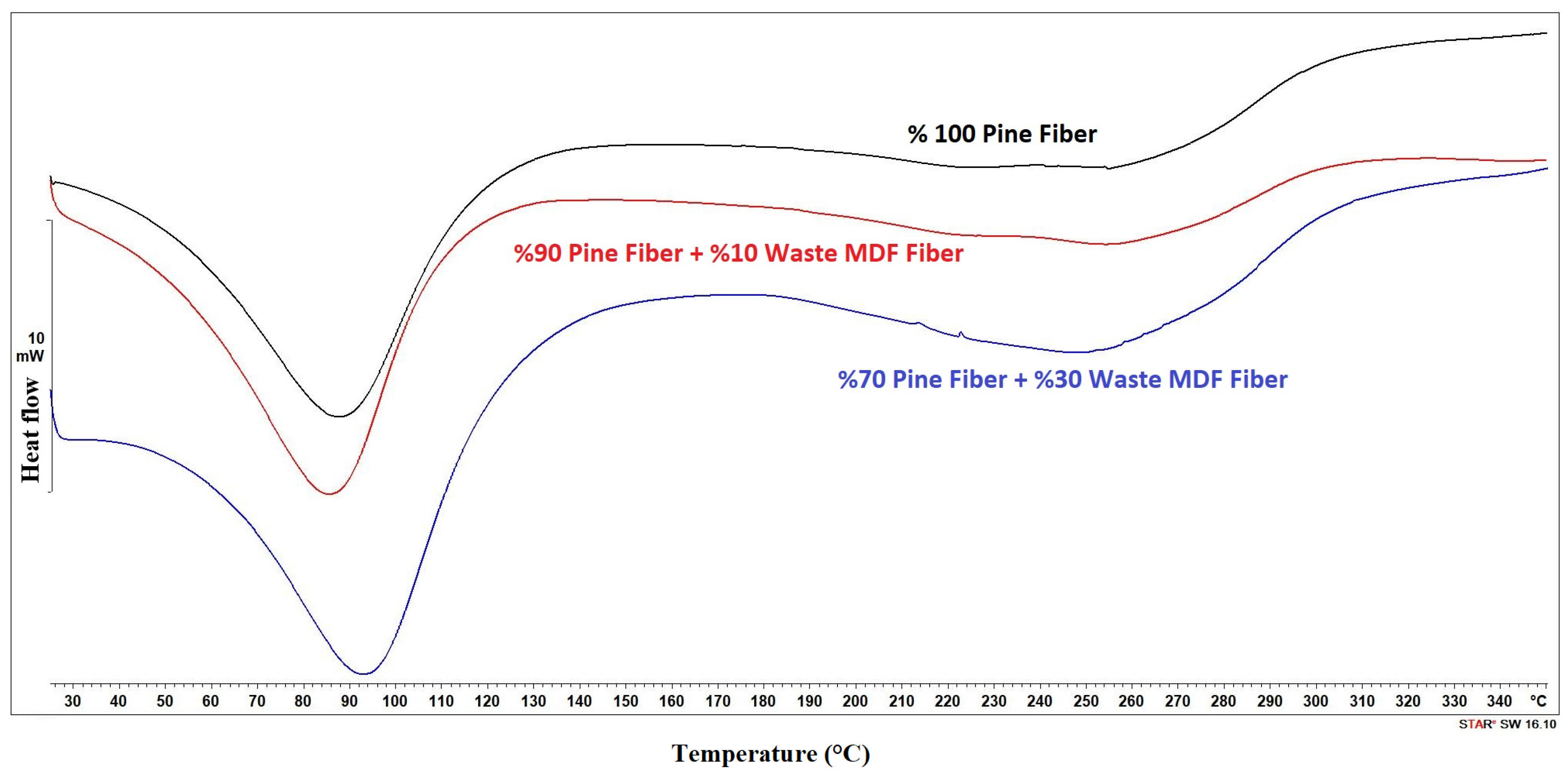


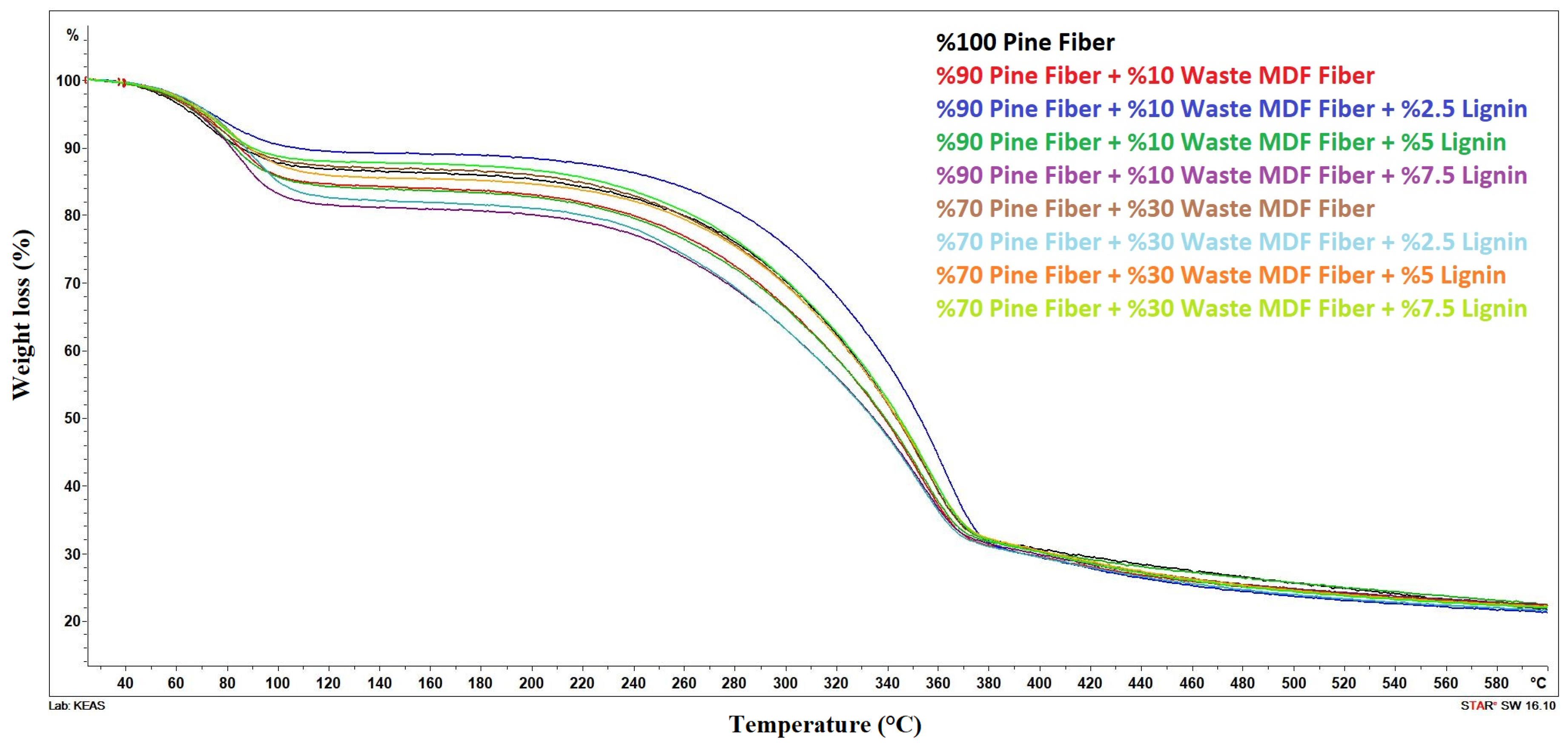
| Property | Unit | Result |
|---|---|---|
| Appearance | Dark brown powder | |
| Solids content | % | 60–70 |
| Ash content | % | <1.5 |
| Sulfur | % | <2.5 |
| Waste carbohydrates | % | <2 |
| pH (40% water solution) | 2.5–3.5 | |
| Moisture content | % | ≤4 |
| Density | kg/m3 | 550–650 |
| Average molecular weight | Mw | 5500–7500 |
| Property | Unit | Result | |
|---|---|---|---|
| UF Resin | Paraffin | ||
| Solids content | % | 50.0 | 60.4 |
| Viscosity | cps | 17–50 | - |
| Density | g/cm3 | 1.190–1.225 | 0.95 |
| Gel time | s | 40–100 | - |
| pH | 7.8–9 | 9.9 | |
| Flow time | s | - | 18.7 |
| Melting point | °C | - | 62 |
| Fiber and Lignin Contents in the MDF Panels | |||
|---|---|---|---|
| MDF Code | Fresh Wood Fiber (wt%) | Recycled Wood Fiber (wt%) | Lignin (wt%) |
| A | 100 | 0 | 0 |
| B | 90 | 10 | 0 |
| C | 90 | 10 | 2.5 |
| D | 90 | 10 | 5 |
| E | 90 | 10 | 7.5 |
| F | 70 | 30 | 0 |
| G | 70 | 30 | 2.5 |
| H | 70 | 30 | 5 |
| I | 70 | 30 | 7.5 |
| Lignocellulosic Material Composition in MDF (% Weight) | Onset (°C) | Peak (°C) | Endset (°C) | tcuring (°C/min) |
|---|---|---|---|---|
| 100 pine fiber | 266.5 | 303.6 | 348.2 | 8.2 |
| 90 pine + %10 recycled fiber | 276.6 | 303.4 | 344.2 | 6.8 |
| 90 pine + %10 recycled fiber + 2.5 lignin | 272.4 | 308.0 | 348.1 | 7.6 |
| 90 pine + %10 recycled fiber + 5 lignin | 270.5 | 304.5 | 349.6 | 7.9 |
| 90 pine + %10 recycled fiber + 7.5 lignin | 267.1 | 305.9 | 344.5 | 7.7 |
| 70 pine + %30 recycled fiber | 272.5 | 308.0 | 350.4 | 7.8 |
| 70 pine + %30 recycled fiber + 2.5 lignin | 260.6 | 305.4 | 349.5 | 8.9 |
| 70 pine + %30 recycled fiber + 5 lignin | 271.5 | 304.5 | 328.9 | 5.7 |
| 70 pine + %30 recycled fiber + 7.5 lignin | 277.0 | 305.9 | 349.3 | 7.3 |
| Lignocellulosic Material Composition in MDF (% Weight) | Moisture (%) | Onset (°C) | Peak (°C) | Mass Loss (%) | Residual Mass (%) |
|---|---|---|---|---|---|
| 100 pine fiber | 13 | 274.8 | 351.0 | 56 | 31 |
| 90 pine + %10 | 16 | 269.3 | 349.7 | 54 | 30 |
| 90 pine + %10 recycled fiber + 2.5 lignin | 11 | 296.1 | 359.0 | 60 | 29 |
| 90 pine + %10 recycled fiber + 5 lignin | 16 | 275.6 | 350.3 | 56 | 28 |
| 90 pine + %10 recycled fiber + 7.5 lignin | 19 | 266.3 | 349.5 | 51 | 30 |
| 70 pine + %30 recycled fiber | 13 | 278.5 | 350.7 | 56 | 31 |
| 70 pine + %30 recycled fiber + 2.5 lignin | 18 | 270.3 | 349.2 | 53 | 29 |
| 70 pine + %30 recycled fiber + 5 lignin | 15 | 265.4 | 352.0 | 55 | 30 |
| 70 pine + %30 recycled fiber + 7.5 lignin | 12 | 275.0 | 352.2 | 58 | 30 |
Disclaimer/Publisher’s Note: The statements, opinions and data contained in all publications are solely those of the individual author(s) and contributor(s) and not of MDPI and/or the editor(s). MDPI and/or the editor(s) disclaim responsibility for any injury to people or property resulting from any ideas, methods, instructions or products referred to in the content. |
© 2023 by the authors. Licensee MDPI, Basel, Switzerland. This article is an open access article distributed under the terms and conditions of the Creative Commons Attribution (CC BY) license (https://creativecommons.org/licenses/by/4.0/).
Share and Cite
Gürsoy, S.; Ayrilmis, N. Effect of Lignin Modification of Recycled and Fresh Wood Fibers on Physical, Mechanical, and Thermal Properties of Fiberboard. Forests 2023, 14, 2007. https://doi.org/10.3390/f14102007
Gürsoy S, Ayrilmis N. Effect of Lignin Modification of Recycled and Fresh Wood Fibers on Physical, Mechanical, and Thermal Properties of Fiberboard. Forests. 2023; 14(10):2007. https://doi.org/10.3390/f14102007
Chicago/Turabian StyleGürsoy, Samet, and Nadir Ayrilmis. 2023. "Effect of Lignin Modification of Recycled and Fresh Wood Fibers on Physical, Mechanical, and Thermal Properties of Fiberboard" Forests 14, no. 10: 2007. https://doi.org/10.3390/f14102007






